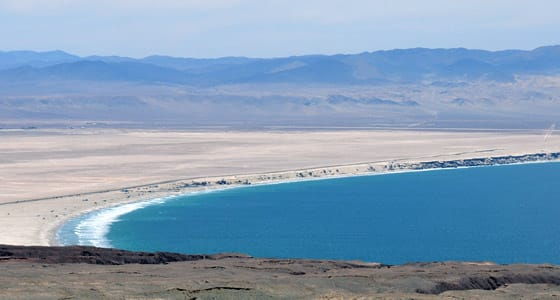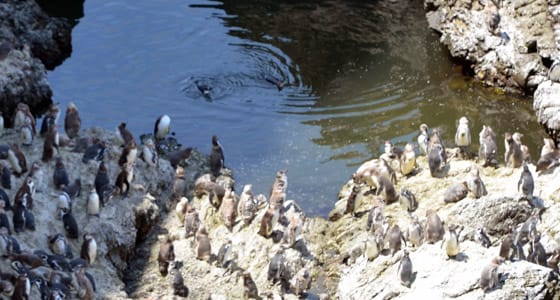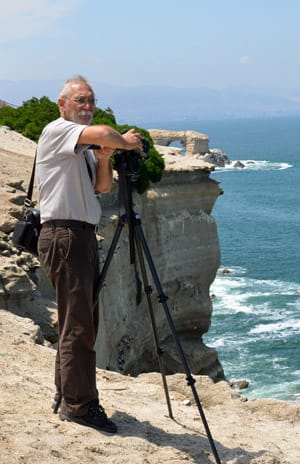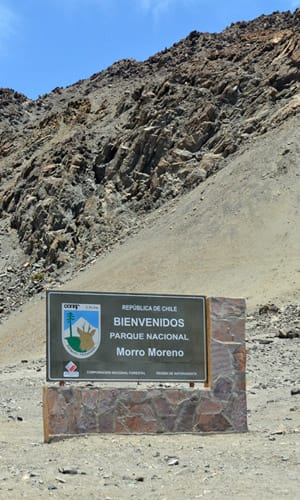We finally had some time to look around this fascinating area. In Chile the distances are huge, and some places that would be nice to see are “just” some 490 km away, which makes it impractical to try and visit when you have a day to do it. To make the rest day most enjoyable and still see something we have decided to limit our scope to the Mejillones peninsula.
The area is only about 40 min away from Antofagasta by car, yet it offers a visitor plenty of sweeping views and an opportunity to formulate an impression of the Chilean coast. For me, this was “Ocean and Desert”. Where else can you imagine the ocean and desert touching each other?

The trip naturally starts with visiting La Portada. The locals are proud of this natural arch located to the North of the city. Again, I saw online reviews saying “5 minutes is enough at La Portada, it is a rock arch”. Yes it is that, indeed. Whether 5 minutes is enough you can decide for yourself; if you are not inclined to admire nature’s wonders you may be better off looking at La Portada’s online pictures. I found it required way more than that, especially if you actually listen to the wildlife officer stationed there on the weekends who will gladly tell you about and even point out to you the hidden jewels of the small park.

For me the neatest thing was, there is a permanent colony of Humboldt penguins living at La Portada. There are about 700 of them down there, but to see them you have to go around the slightly rundown restaurant area and descend down a flight of rickety stairs that lead seemingly nowhere. At the bottom of the stairs there is a small sloping area covered with loose sand and gravel, perched atop a 100 foot sandstone drop-off. You can see the evidence of this sandstone occasionally breaking off along the coastline, so going down to this area is up to you. I am thinking, in the U.S. this area would be fenced off with a 10 foot chainlink fence extending a mile in each direction, and a TV monitor that would allow watching the penguins. In Chile, the officers supervising the park simply say “Be careful, there is no handrails and you can fall down” and leave you to be a responsible adult.

I guess the Chileans haven’t figured out yet that some individuals can try to become reach by suing others as being responsible for their own stupidity, so this little park still is open to the public. On the second thought though, if you went over the edge there I don’t think you would live to enjoy the benefits from a lawsuit, even if there were any.
The penguins perch on the sea-washed rocks at the bottom of the sandstone cliffs, swim in the pools, dive through the surf and flap their little wings and wiggle their tails. They are always busy doing something, and I could watch them for hours.
In addition to the penguins there is a variety of other sea birds at the park, and you can see them both in the air and on the water. The park also has a boardwalk leading down to the water edge, however this boardwalk was closed all the times we were there.
Continuing along the roads through the Mejillones Peninsula you will find yourself crossing vast expanses of dry gravel desert. There is no biosphere to speak of, no plants, or animals, or insects. There is no fresh water. The wind blows all the time, sometimes harder, sometimes much harder. If you keep driving to the West you will arrive in Juan Lopez, a small town that on weekends hosts a bit of a festivity. There are a couple of places to eat, with decent food and very low prices for both food and beverage. The buildings are fairly upscale for a coastal Chilean village, and the roads are mostly paved. When we drove through it the air was filled with the aroma of meat cooked over the charcoals. For a while we contemplated giving in and joining the people sitting in the shade of the red Coca Cola umbrellas and indulging in some local food but the desire to see more prevailed. You can eat later if you want; this was our only chance to see something, so we ignored the food.

The second road through Mejillones goes North, to the little town of Santamaria. Compared to it, Juan Lopez is a metropolis. The buildings in Santamaria are made of drywall, without any outside sheeting – I guess this is ok to do in a place where it never rains, or of corrugated iron. There were no eateries that we could tell. There were people working in the fishing boats, taking bundles of sea weeds out of them and putting them onto a truck, and some children fishing off a pier and riding bicycles back and forth along the 200 foot stretch of pavement leading to the pier. I really felt like a tourist in this small village, way overdressed in light colored clothes, and especially with a camera that looked more expensive than the vehicles and boats owned by the locals.
Judging from the curious glances, wandering gringos are not very typical in Santamaria. We did not feel any hostility, short of some awkwardness that I felt from being in a place so obviously poor.

From Santamaria we continued further Northwest to the Morro Moreno national park. This is the first place where we saw native vegetation. It consisted of three or four gnarly little bushes some 3 inches in height, with leaves looking like tiny bulbs. The outer perimeter of the bushes was devoid of the leaves and the soil looked like a little path, as if some animals ran around them a lot and ate all the leaves. Maybe this is what it was but we didn’t get to see any wildlife.
After the entrance sign the road becomes a little bit on the rough side, and another half a mile later it becomes unsuitable for a passenger car. A 4WD vehicle will have no problems, and you can drive all the way across the ridge and down onto the plain on the coast on the other side. We just limited ourselves to a short walk to the top of the ridge and looked out onto the ocean to the North. The rugged dry country with nothing around but dry, hot, sun-baked rock and gravel, left a bit of a daunting impression on me: being from the cold but wooded North, I consider forest a home with nothing to be afraid of. This arid land will left you parched and helpless in no time. I had the feeling that there is no messing around with the desert, it gained my utmost respect. What an amazing landscape though!
On the way back to Antofagasta at the end of this day full of impressions we stopped on the bay for a swim in the ocean. The beach on the bay is several miles long, and the locals pull off the highway at random places, drive up onto the sand and have parties. There can be quite a bit of trash left behind but there are cleaner places one can find, and we enjoyed one of them. The Pacific was as peaceful as usual, with 4-foot swells rolling in that built up sand banks and a trench a short distance from the water edge. Once past the trench it was fun to swim in the waves, the water temperature being on the cold side but still very enjoyable. We came across several parts of the beach where the ocean created deposits of just shells and parts of shells. Small fragments 1/4″ to 2″ in size, smooth and rounded from the endless action of the surf, would lay 10″ deep on top of the sand and take up areas of some 50×60 feet, and we sat in the middle of these, fingering the little fragments of shells as if they were memories from the past, and thinking of the endless cycle of life and of how special it was, being here on this deserted beach.